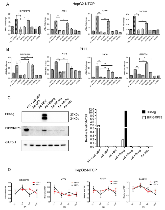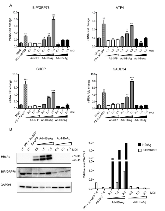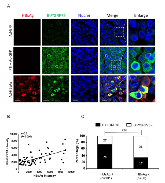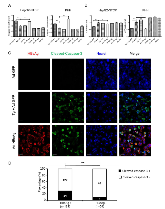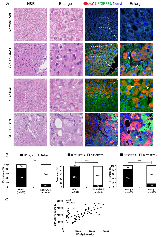|
Hepatitis B virus pre-S2 mutant upregulates cyclin A expression and induces nodular proliferation of hepatocytes
|
journal
|
January 2005 |
|
Hepatitis B virus evades innate immunity of hepatocytes but activates cytokine production by macrophages: Cheng et al.
|
journal
|
November 2017 |
|
Update on prevention, diagnosis, and treatment of chronic hepatitis B: AASLD 2018 hepatitis B guidance
|
journal
|
March 2018 |
|
Characterization of primary human hepatocytes, HepG2 cells, and HepaRG cells at the mRNA level and CYP activity in response to inducers and their predictivity for the detection of human hepatotoxins
|
journal
|
January 2012 |
|
Hair Follicle Melanocytes Initiate Autoimmunity in Alopecia Areata: a Trigger Point
|
journal
|
September 2022 |
|
Tumorigenic and Immunosuppressive Effects of Endoplasmic Reticulum Stress in Cancer
|
journal
|
February 2017 |
|
Ground-glass hepatocytes co-expressing hepatitis B virus X protein and surface antigens exhibit enhanced oncogenic effects and tumorigenesis
|
journal
|
June 2014 |
|
Endoplasmic reticulum stress in liver disease
|
journal
|
April 2011 |
|
Overview of hepatitis B viral replication and genetic variability
|
journal
|
April 2016 |
|
Mechanisms of HBV-induced hepatocellular carcinoma
|
journal
|
April 2016 |
|
EASL 2017 Clinical Practice Guidelines on the management of hepatitis B virus infection
|
journal
|
August 2017 |
|
Diverse virological, histopathological and prognostic implications of seroconversion from hepatitis B e antigen to anti-HBe in chronic hepatitis B virus infection
|
journal
|
January 1986 |
|
Protein misfolding in the endoplasmic reticulum as a conduit to human disease
|
journal
|
January 2016 |
|
Roles of CHOP/GADD153 in endoplasmic reticulum stress
|
journal
|
December 2003 |
|
Interferon-γ and Tumor Necrosis Factor-α Produced by T Cells Reduce the HBV Persistence Form, cccDNA, Without Cytolysis
|
journal
|
January 2016 |
|
Structural and pathological effects of synthesis of hepatitis B virus large envelope polypeptide in transgenic mice.
|
journal
|
October 1987 |
|
X-gene Product of Hepatitis B Virus Induces Apoptosis in Liver Cells
|
journal
|
January 1998 |
|
AKT proto-oncogene overexpression is an early event during sporadic colon carcinogenesis
|
journal
|
January 2002 |
|
Pre-S mutant surface antigens in chronic hepatitis B virus infection induce oxidative stress and DNA damage
|
journal
|
June 2004 |
|
Hepatitis B Virus Deregulates the Cell Cycle To Promote Viral Replication and a Premalignant Phenotype
|
journal
|
July 2018 |
|
Characterization of the Intracellular Deproteinized Relaxed Circular DNA of Hepatitis B Virus: an Intermediate of Covalently Closed Circular DNA Formation
|
journal
|
September 2007 |
|
Hepatitis B Virus Regulates Apoptosis and Tumorigenesis through the MicroRNA-15a-Smad7-Transforming Growth Factor Beta Pathway
|
journal
|
December 2014 |
|
Activation of hepatitis B virus S promoter by the viral large surface protein via induction of stress in the endoplasmic reticulum
|
journal
|
October 1997 |
|
Transfer of Hepatitis B Virus Genome by Adenovirus Vectors into Cultured Cells and Mice: Crossing the Species Barrier
|
journal
|
June 2001 |
|
Inhibition of Cellular Proteasome Activities Enhances Hepadnavirus Replication in an HBX-Dependent Manner
|
journal
|
May 2004 |
|
mTOR and P70 S6 Kinase Expression in Primary Liver Neoplasms
|
journal
|
December 2004 |
|
Hepatitis B Virus Disrupts Mitochondrial Dynamics: Induces Fission and Mitophagy to Attenuate Apoptosis
|
journal
|
December 2013 |
|
Resistance of ground glass hepatocytes to oral antivirals in chronic hepatitis B patients and implication for the development of hepatocellular carcinoma
|
journal
|
March 2016 |
|
Endoplasmic Reticulum Stress, Unfolded Protein Response, and Cancer Cell Fate
|
journal
|
April 2017 |
|
Ground glass hepatocytes provide targets for therapy or prevention of hepatitis B virus-related hepatocellular carcinoma
|
journal
|
January 2018 |
|
Update on Prevention, Diagnosis, and Treatment of Chronic Hepatitis B: AASLD 2018 Hepatitis B Guidance
|
journal
|
July 2018 |
|
Correlation of hepatocyte HBsAg expression with virus replication and liver pathology
|
journal
|
July 1988 |
|
Enhanced expression of vascular endothelial growth factor-A in ground glass hepatocytes and its implication in hepatitis B virus hepatocarcinogenesis
|
journal
|
February 2009 |
|
Hepatitis B virus X protein induces apoptosis by enhancing translocation of Bax to mitochondria
|
journal
|
July 2008 |
|
Expression of a hepatitis B virus pre-S2 deletion mutant in the liver results in hepatomegaly and hepatocellular carcinoma in mice: Hepatomegaly and HCC in HBV pre-S2 mutant transgenic mice
|
journal
|
January 2017 |
|
Different Types of Ground Glass Hepatocytes in Chronic Hepatitis B Virus Infection Contain Specific Pre-S Mutants that May Induce Endoplasmic Reticulum Stress
|
journal
|
December 2003 |
|
Diverse virological, histopathological and prognostic implications of seroconversion from hepatitis B e antigen to anti-HBe in chronic hepatitis B virus infection
|
journal
|
January 1986 |
|
Type II ground-glass hepatocytes as a marker of hepatocellular carcinoma in chronic hepatitis B
|
journal
|
August 2013 |
|
ER stress: Can the liver cope?
|
journal
|
August 2006 |
|
The endoplasmic reticulum stress response in immunity and autoimmunity
|
journal
|
September 2008 |
|
Signal integration in the endoplasmic reticulum unfolded protein response
|
journal
|
July 2007 |
|
The unfolded protein response: controlling cell fate decisions under ER stress and beyond
|
journal
|
January 2012 |
|
Evidence against in utero transmission of hepatitis B virus
|
journal
|
April 2021 |
|
Increased infiltration of regulatory T cells in hepatocellular carcinoma of patients with hepatitis B virus pre-S2 mutant
|
journal
|
January 2021 |
|
The hepatitis B virus X protein abrogates Bcl-2-mediated protection against Fas apoptosis in the liver
|
journal
|
January 2002 |
|
X Protein of Hepatitis B Virus Inhibits Fas-mediated Apoptosis and Is Associated with Up-regulation of the SAPK/JNK Pathway
|
journal
|
November 2000 |
|
An Overview of Unfolded Protein Response Signaling and Its Role in Cancer
|
journal
|
October 2017 |
|
Ground glass hepatocytes contain pre-S mutants and represent preneoplastic lesions in chronic hepatitis B virus infection
|
journal
|
August 2008 |
|
Vascular Endothelial Growth Factor and Angiogenesis
|
journal
|
December 2004 |
|
The Unfolded Protein Response: From Stress Pathway to Homeostatic Regulation
|
journal
|
November 2011 |
|
Hepatitis B Virus Deregulates the Cell Cycle To Promote Viral Replication and a Premalignant Phenotype
|
journal
|
July 2018 |
|
Characterization of the Intracellular Deproteinized Relaxed Circular DNA of Hepatitis B Virus: an Intermediate of Covalently Closed Circular DNA Formation
|
journal
|
September 2007 |
|
Hepatitis B Virus Regulates Apoptosis and Tumorigenesis through the MicroRNA-15a-Smad7-Transforming Growth Factor Beta Pathway
|
journal
|
December 2014 |
|
Activation of hepatitis B virus S promoter by the viral large surface protein via induction of stress in the endoplasmic reticulum
|
journal
|
October 1997 |
|
Transfer of Hepatitis B Virus Genome by Adenovirus Vectors into Cultured Cells and Mice: Crossing the Species Barrier
|
journal
|
June 2001 |
|
Inhibition of Cellular Proteasome Activities Enhances Hepadnavirus Replication in an HBX-Dependent Manner
|
journal
|
May 2004 |
|
mTOR and P70 S6 Kinase Expression in Primary Liver Neoplasms
|
journal
|
December 2004 |
|
Overview of hepatitis B virus mutations and their implications in the management of infection
|
journal
|
January 2016 |
